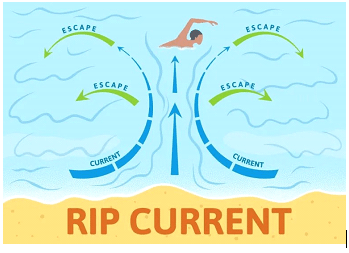If you plan to spend a day at the beach, it is essential that you know how to identify rip currents and what to do if you become entangled in one. A day at the beach can be disastrous if beachgoers are unaware of the ocean’s regulations and the sea’s processes. In particular, the presence of dangerous rip currents can pose a significant threat to uninformed individuals.
What causes rip currents to develop?
The formation of rip currents is typically the result of a convergence of elements, including waves, wind, and the coastline configuration. On beaches with a steep decline, where the waves break in close proximity to the shore, they are more prevalent. As waves break, they propel water towards the coastline, causing a buildup that must be drained back into the ocean. This is the precise moment when rip currents form, as water rapidly retreats along a concentrated path towards the ocean.
They manifest as narrow, powerful currents of water that move away from the coast. In the open ocean, their powerful force has the potential to drag even the most skilled swimmers to great distances. While they may be difficult to detect, understanding their characteristics enables you to recognize and avoid them, ensuring your safety in the water.
identifying rip currents
Despite the fact that there are numerous warning signs, detecting rip currents can be challenging. Nonetheless, observe the wave’s direction. The waves should be rolling towards the beach and breaking close to the shore, with a white, foamy crest. In contrast to the surrounding water, rip currents often appear deceptively calm along the coast. In addition, it may alter the wave pattern such that the water does not break as expected. For those unfamiliar with the ocean, it may appear to be an ideal, wave-free place to enter the water. These indicators frequently indicate the presence of rip currents.

It is imperative to avoid entering the ocean in regions where such currents are developing. It is of the utmost importance to avoid these areas due to the high risk associated with rip currents. These currents are capable of dragging even the most skilled swimmers deep into the ocean, and they are difficult to swim against. Additionally, it becomes exceedingly difficult to rescue individuals caught in these currents, as rescuers would also become entangled in the relentless flow.
What actions are necessary if you become caught in a rip current?
In the event that you are caught in a rip current, you must maintain a level head. Resisting the current will only lead to exhaustion; instead, swim parallel to the shore, synchronizing your movements with the current until you are free of its influence. After successfully escaping the current, you can return to the shore by swimming. It is important to note that strong swimming skills are not required to overcome a rip current. By floating on your back and paddling with your hands, you can return to the shore more easily. After escaping it, you may feel extremely exhausted. In such situations, it is prudent to float on your back instead of attempting to swim toward the shore, allowing the natural movement of the waves to propel you towards the shore.

Distinguishing between Rip Currents, Rip Tides, and Undertows
Undertows are generally less powerful than rip currents and occur when water retreats back into the ocean after a wave crashes. When large waves break on a beach, they generate a significant water and sand surge and backflow. This mixture of water and sand returns to the ocean and is absorbed by the next breaking wave. If caught in an undertow, it may feel like you are being pulled underwater as the wave crashes above you. Although you may encounter some turbulence from the waves, the undertow does not typically pull you far out to sea and is less dangerous for adults. However, this can be a concern for children who may lack the strength to resist the pull of the water when attempting to walk back up the beach.
It is important to remember that rip currents differ from rip tides and undertows. Rip tides are determined by the gravitational forces exerted by the moon and sun and have no relation to waves or wind. They manifest as strong currents caused by the tide’s passage of water through an inlet along a barrier beach. When the tide recedes, there is a strong flow of water through the inlet, which is directed towards the ocean. Without knowledge of tides and tidal movements, it is extremely hazardous and difficult to predict these occurrences.
To conclude it
Despite the inherent dangers of rip currents, it is crucial for your safety in the water to be able to identify them and know how to react if you become entangled in one. It is important to always be aware of your surroundings and to avoid swimming alone. Avoid beaches with large waves and consider wearing a life jacket if you are not a strong swimmer. In addition, pay attention to signs indicating the presence of rip currents or strong undertows, as well as beaches that are notorious for these conditions. If red flags are flying at the beach, it is best to avoid entering the water. By arming yourself with knowledge and taking appropriate precautions, you can enjoy a beach day without worry.

